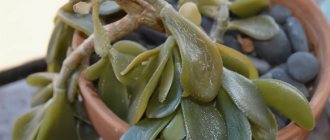Leaves turn yellow and dry out
It is a pity if large violet leaves begin to dry out, especially when they should not do so. But this is exactly the problem that flower growers face most often!
— Violet leaves turn yellow and wither if the conditions are not suitable for it, because each variety has its own characteristics;
— Leaves may turn yellow if they are constantly exposed to water when watering;
— Ring yellow spots appear in winter when the flowerpot is in a draft;
— The plant turns yellow, becomes stunted and lethargic due to root rot. Then urgent drying and replanting with fungicide treatment is needed;
— Wide yellow trails on the leaves are left by thrips when they eat away the pulp.
Photo: raiclimat.ru
Why does the violet wither?
Violets are very beautiful ornamental plants, but at the same time they are also very capricious. Any disturbance to their habitat can affect the appearance of the flower. They are also susceptible to pests, especially fungi. Let's look at the most common reasons why Saintpaulias may wither.
Lack of light or excess of it
Violets need to receive at least 12 hours of daylight per day. In winter, when the days become short and cloudy, they may lack light. In this case, they must be illuminated with artificial lamps.
An excess of light radiation also negatively affects their well-being. In addition, they do not tolerate the sun's burning rays at all. As soon as the plant stands on the windowsill in the summer, on the south side, after a few days you will notice that the leaves begin to turn yellow and wither.
The light should be moderate. Its deficiency or excess causes the flower to wither.
Improper watering
The Saintpaulia root system is located close to the soil surface. If you water the plant with strong pressure, the soil will wash away and the roots will begin to become exposed. You may not immediately notice this under the leaves, but the plant will definitely react to the discomfort.
Violet, in general, is very sensitive to watering: it needs to be moistened 2-3 times a week in summer and once in winter. Excessive moisture or, conversely, drying out will also cause the violet to become lethargic.
The quality of the water is also important: it is better to purify it through a filter or to settle it well. The temperature of the water when watering should not be lower than +18 degrees.
Lack of fertilizers or saturation with them
Violet leaves often wither because the plant lacks nutrients. This happens especially often in the spring, when the flower begins to grow rapidly and especially needs feeding.
But if you “overdo it” with vitamins, you can cause serious harm to Saintpaulia. Therefore, it is very important to follow all the recommendations indicated on the drug that you use for feeding.
Bad soil
A flower bought in a store may look quite healthy. Typically, plants are flavored with nutritional compounds so that they maintain their presentation. But the quality of the substrate is not always good.
In any case, it is recommended to replant violets purchased in stores, since no one will tell you exactly what kind of soil they have and how long they have been in it.
For replanting, it is best to use a ready-made substrate designed specifically for Saintpaulias; it can be found in any flower growing stores.
Pests
If there are parasites (fungi, bacteria, insects) on the leaves or in the soil, then the first symptoms may be the wilting of the violet, the appearance of spots, and the drooping of the leaves.
If a disease is detected, you must quickly take action:
- separate the plant from healthy ones,
- treat with a medicinal preparation (in flower shops you can find remedies for any pests),
- and then transplant the Saintpaulia into fresh soil.
Air temperature and humidity
Violets love warmth. They need a stable temperature around +18-25 degrees. At lower temperatures they freeze, and at higher temperatures they wither. They do not tolerate sudden changes in temperature. Therefore, it is worth keeping them in rooms where there is always an even, stable atmosphere.
The plant is also sensitive to air humidity. The optimal figure is 60-70%. But Saintpaulia will tolerate high humidity more easily than dry air.
Do not keep flowers above heating appliances, and if the air in the house is dry, place containers of water near the pots.
Violets also do not like drafts, so placing them near open windows, under an air conditioner or fan is not the best option.
Brown spots on violet leaves
Household violets rarely suffer from fungus, but this happens much more often with outdoor flower beds. And the first symptoms may be rusty, brown or brown spots on the leaves.
— Large brown spots appear on delicate leaves from cold and drafts;
— The leaves turn brown when the violet lacks nutrients. Indeed, during flowering, it absorbs them twice as actively;
— Textured red spots appear when damaged by rust. She likes humid but fairly cool days. Sometimes orange bumps appear;
— Brown soft shoots and leaves are a sure sign of brown rot of the same name, which most often affects young plants;
— Brown spots on the leaves due to late blight dry out and spread almost before our eyes;
— The leaves begin to darken and rot from the stem and petiole if the violet suffers from fusarium. The disease affects the root system, and it is almost impossible to cure it;
— Chaotic brown streaks combined with a stop in development indicate an incurable bronze virus;
— The leaves darken at the edges when the violet soil is too wet and needs to be dried.
Photo: aa2aa.ru
Petunia leaf diseases: descriptions with photos, treatment
Negative factors
The flower is a heat-loving crop, but does not tolerate exposure to direct sunlight. The tender violet leaves first turn yellow, then dry out completely. The flower will recover if it is placed in a well-lit place, but excluded from sunlight.
Other reasons for plant wilting:
- Pests. There may be mites on the back of the leaves. The small size of adult individuals does not allow timely detection of pests. A characteristic sign of infection is the appearance of yellow-brown spots and drying of the leaves. Various fungal diseases can also pose a danger. It is necessary to regularly inspect the plant to detect signs of infection and begin treatment on time.
- Watering. If there is excess moisture, the roots begin to rot, and the violet leaves in this case darken at the tips. The structure of the entire surface of the leaf gradually changes and it disappears. The flower can be revived by transplanting it into a new substrate, removing damaged parts from the root system. With insufficient watering, the leaves turn yellow, brown, and gradually dry out. The situation can be corrected by normalizing watering the plant.
- Fertilizers. Both the lack of fertilizing and the excess dosage of fertilizers have a negative effect on the development of the flower. In the first case, the growth of the violet slows down, the lower leaves gradually die off. If there is an excess of nutrients, the plant dries out quickly. In both cases, replanting and correction of the feeding regime are necessary.
The causes of flower wilting can be poor soil, hypothermia, or a sharp change in temperature.
White coating on violet leaves
At first, the white coating may seem like a thick layer of dust. The leaves of the violet are textured in themselves, so at first it is not too visible whether there is a coating or cobwebs on them.
— An intense white coating is left by powdery mildew, one of the most common fungi on plants;
— A grayish coating on brown softened leaves is a symptom of gray rot or botrytis;
— Pale mucous plaque on hot summer days is a sign of vascular bacteriosis. It is urgent to establish ventilation and lower the air temperature;
—Large white flakes throughout the plant indicate the presence of mealybugs;
- A silvery coating that quickly darkens or turns red appears due to downy mildew.
Photo: sanpros.ru
Diseases of raspberry leaves: descriptions with photos, treatment
Adjustment of care rules
If Saintpaulia loses turgor, you should go through all the points to understand why the violet withers in the pot. Violets grow well if:
But in some cases, the measures taken do not lead to the desired result. You can simply transplant the Saintpaulia into another pot, seating the children too.
The reason could lie precisely in the lack of nutrition, humidity, or light, if many daughter rosettes grew around the mother bush.
If the violet continues to wither, it is necessary to remove all the dried leaves, trim the plant at the root and place it in water for new roots to appear. There is hope that this method will revive the violet.
Like any cultivated plant, violet needs care and attention. If the owners often leave, during planting you can arrange a wick system for watering the plants. For this you need a synthetic cord. Operating procedure:
Violets respond well to wick watering.
Pale and light leaves
Most varieties of violets grow with beautiful decorative leaves, so it is quite easy to notice when they fade and fade. Find out the reason and quickly adjust the care - then the flower will recover on its own!
- Sucking insects draw out all the juices from the violet, and it fades and withers;
— Nematodes eat the root system, which is why the above-ground part grows weak, sluggish, pale and deformed.
Photo: domashniecvety.ru
Diseases of strawberry leaves: descriptions with photos, treatment
Find out what to do if your violet withers
Saintpaulia or Uzambara violet is a low-growing herbaceous plant of the Gesneriev genus. In the wild, it is found in the mountainous regions of Kenya and Tanzania near rivers and waterfalls. It became known in Europe in 1893, when a flowering plant was grown from seeds sent from East Africa. Saintpaulia violetflower received its name in honor of its discoverer, Saint-Paul Illaire.
It is a perennial plant that forms a rosette with green velvety leaves with pointed tips. Saintpaulia flowers range from 2 to 5 cm in diameter.
With proper care, violets can bloom up to 8 months a year. But sometimes, for no apparent reason, Saintpaulia begins to fade. At this moment, it is important not to overlook the problem and take measures to save the plant. Otherwise, the flower may die or stop blooming.
Wilting should never be ignored.
How to save and revive a violet?
Reanimation of a plant can vary greatly depending on the cause. If the violet disappears due to factors related to the conditions in the room, then resuscitating them is quite simple, but it is important to follow all the rules.
Hypothermia and freezing
What to do if the violet is frozen depends on the area affected by the cold:
This is what frozen leaves look like.
Sunburn
With the harmful effects of sunlight, only the upper part of the violet suffers. Ways to revive an indoor violet depend on the severity of the damage:
Sunburn on leaves.
Improper watering
Moisture-loving Saintpaulias react very seriously to improper watering. If there is a lack of moisture or violet overflow - what to do:
Violet stalk with roots.
Bad soil
Incorrectly selected or old soil can lead to rotting of the root system.
In this case,
you can save the plant from death only by re-rooting it:
Treatment options
Most violet diseases are incurable, and therefore little helps in the fight against them. Infected flowers are removed from other plants and destroyed along with the soil lump.
However, if there is hope of saving at least one specimen, then fungicides will come to the rescue.
The drugs are aimed at destroying fungal spores and counteracting infections. In addition to proper processing, violets need to change their maintenance conditions:
- reducing humidity levels by reducing watering of flowers;
- placing violets in a warm and well-lit place;
- removing the top layer of soil in which fungal spores can live.
The most spectacular varieties of violets: “Dance of Galaxies”, “Duchess”, “Wind Rose”, “Ice Rose” and “Royal Lace”.










